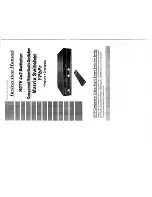
Features
LEDs
The four indicator LEDs on the front panel indicate power, the status of the Inhibit BNC input,
clockwise rotation and counterclockwise rotation.
Manual Rotational Buttons
The commutator features both clockwise and counterclockwise manual rotational buttons.
When pressed, these buttons will rotate the commutator at approximately 18 RPM. Pressing
either of these buttons also overrides the current rotational state of the commutator.
Inhibit BNC
During critical recording periods it may be necessary to prevent rotation to ensure signal
integrity. A logical low (0) on the Inhibit BNC will prohibit any rotation initiated by either the
sensors on the commutator or the manual rotational button.
External Ground
A banana jack located on the face (GND) provides connections to common ground on the
commutator.
The external ground is optional and should only be used in cases where the subject must
occasionally make contact with a metal surface that isn't tied to the animal ground, such as a
lever press. When contact is made, a ground loop is formed that temporarily adds extra noise
to the system. Grounding this metal surface directly to the TDT hardware removes this ground
loop at the cost of raising the overall noise
fl
oor a small amount.
A cable kit is provided to ensure cables used with the external ground are suitable for this use.
Each kit includes: one male banana plug to male banana plug pass through and one male
P
Power (~0.5 Hz
fl
ash when on)
I
Inhibit
Counterclockwise rotation
Clockwise rotation
ACO32/ACO64 Motorized Commutators | 7







































